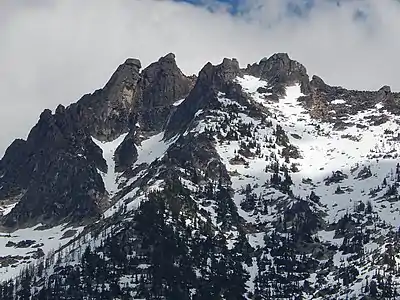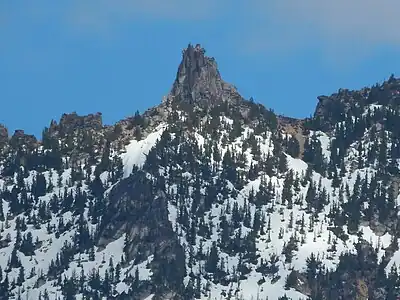| Vasiliki Ridge | |
|---|---|
 Vasiliki seen from North Cascades Highway near Washington Pass | |
| Highest point | |
| Elevation | 8,330 ft (2,540 m)[1] |
| Prominence | 390 ft (120 m)[1] |
| Coordinates | 48°33′38″N 120°35′45″W / 48.560671°N 120.595806°W[1] |
| Geography | |
 Vasiliki Ridge Location in Washington  Vasiliki Ridge Vasiliki Ridge (the United States) | |
| Location | Okanogan County Washington, U.S. |
| Parent range | North Cascades |
| Topo map | USGS Silver Star Mountain |
| Geology | |
| Type of rock | Granite |
| Climbing | |
| First ascent | May 31, 1952 Fred Beckey, Herb Staley[2] |
| Easiest route | Climbing |
Vasiliki Ridge[3] is a three-mile-long ridge located in Okanogan County of Washington state. It is part of the Methow Mountains which is a sub-range of the North Cascades. Vasiliki Ridge is situated north of Silver Star Mountain on land administered by the Okanogan–Wenatchee National Forest. The name Vasiliki was recommended by climber Fred Beckey who made the first ascent in 1952.[3] Vasiliki Ridge can be seen from Washington Pass and from the North Cascades Highway.
Vasiliki Ridge summit, at 8,190 feet elevation, is the highest point on Vasiliki Ridge. Named granite spires include Charon Tower, The Acropolis, Ares Tower, Vasiliki Tower, Juno-Jupiter Towers, Aphrodite Tower, and Baccus Tower.[2] Precipitation runoff from the ridge drains into Early Winters Creek which is a tributary of the Methow River.
Climate
Weather fronts originating in the Pacific Ocean travel northeast toward the Cascade Mountains. As fronts approach the North Cascades, they are forced upward by the peaks of the Cascade Range, causing them to drop their moisture in the form of rain or snowfall onto the Cascades (Orographic lift). As a result, the west side of the North Cascades experiences high precipitation, especially during the winter months in the form of snowfall. During winter months, weather is usually cloudy, but, due to high pressure systems over the Pacific Ocean that intensify during summer months, there is often little or no cloud cover during the summer.[4] Because of maritime influence, snow tends to be wet and heavy, resulting in high avalanche danger.[4]
Geology
The North Cascades features some of the most rugged topography in the Cascade Range with craggy peaks, ridges, and deep glacial valleys. Geological events occurring many years ago created the diverse topography and drastic elevation changes over the Cascade Range leading to various climate differences. These climate differences lead to vegetation variety defining the ecoregions in this area.
The history of the formation of the Cascade Mountains dates back millions of years ago to the late Eocene Epoch.[5] With the North American Plate overriding the Pacific Plate, episodes of volcanic igneous activity persisted.[5] In addition, small fragments of the oceanic and continental lithosphere called terranes created the North Cascades about 50 million years ago.[5] Vasiliki Ridge is carved mostly from granite of the Golden Horn batholith.
During the Pleistocene period dating back over two million years ago, glaciation advancing and retreating repeatedly scoured the landscape leaving deposits of rock debris.[5] The U-shaped cross section of the river valleys is a result of recent glaciation. Uplift and faulting in combination with glaciation have been the dominant processes which have created the tall peaks and deep valleys of the North Cascades area.
See also
Gallery
 Vasiliki Tower
Vasiliki Tower Juno-Jupiter Tower
Juno-Jupiter Tower The Acropolis, Charon Tower
The Acropolis, Charon Tower Summit, Ares Tower
Summit, Ares Tower Aphrodite Tower
Aphrodite Tower
References
- 1 2 3 "Vasiliki Ridge, Washington". Peakbagger.com.
- 1 2 Beckey, Fred W. (2009). Cascade Alpine Guide: climbing and high routes, Vol. 3, Rainy Pass to Fraser River (3rd ed.). Mountaineers Books. ISBN 978-1-59485-136-0.
- 1 2 "Vasiliki Ridge". Geographic Names Information System. United States Geological Survey, United States Department of the Interior. Retrieved 2018-07-24.
- 1 2 Beckey, p. 16
- 1 2 3 4 Kruckeberg, Arthur (1991). The Natural History of Puget Sound Country. University of Washington Press.
External links
- Weather: Vasiliki Ridge